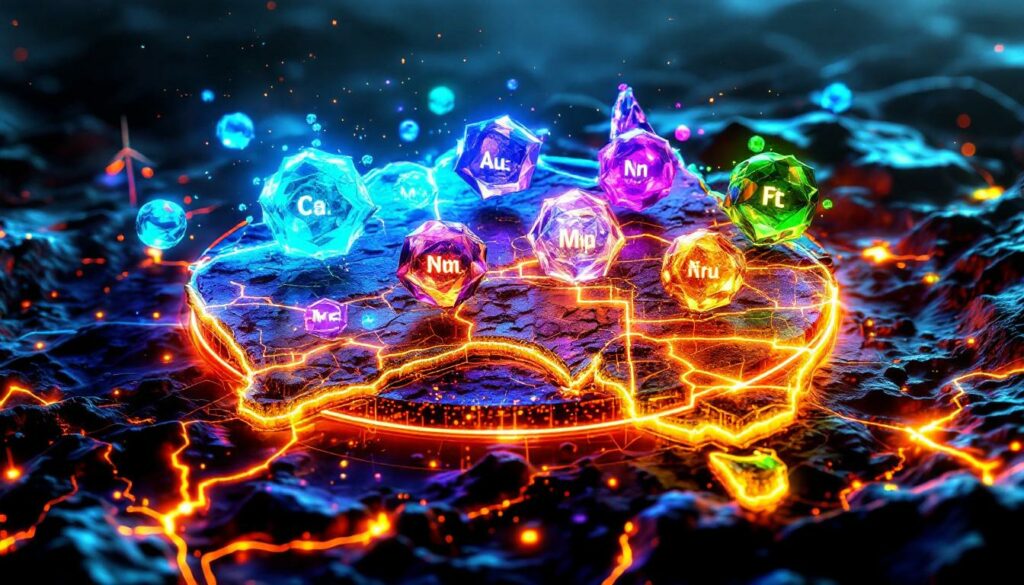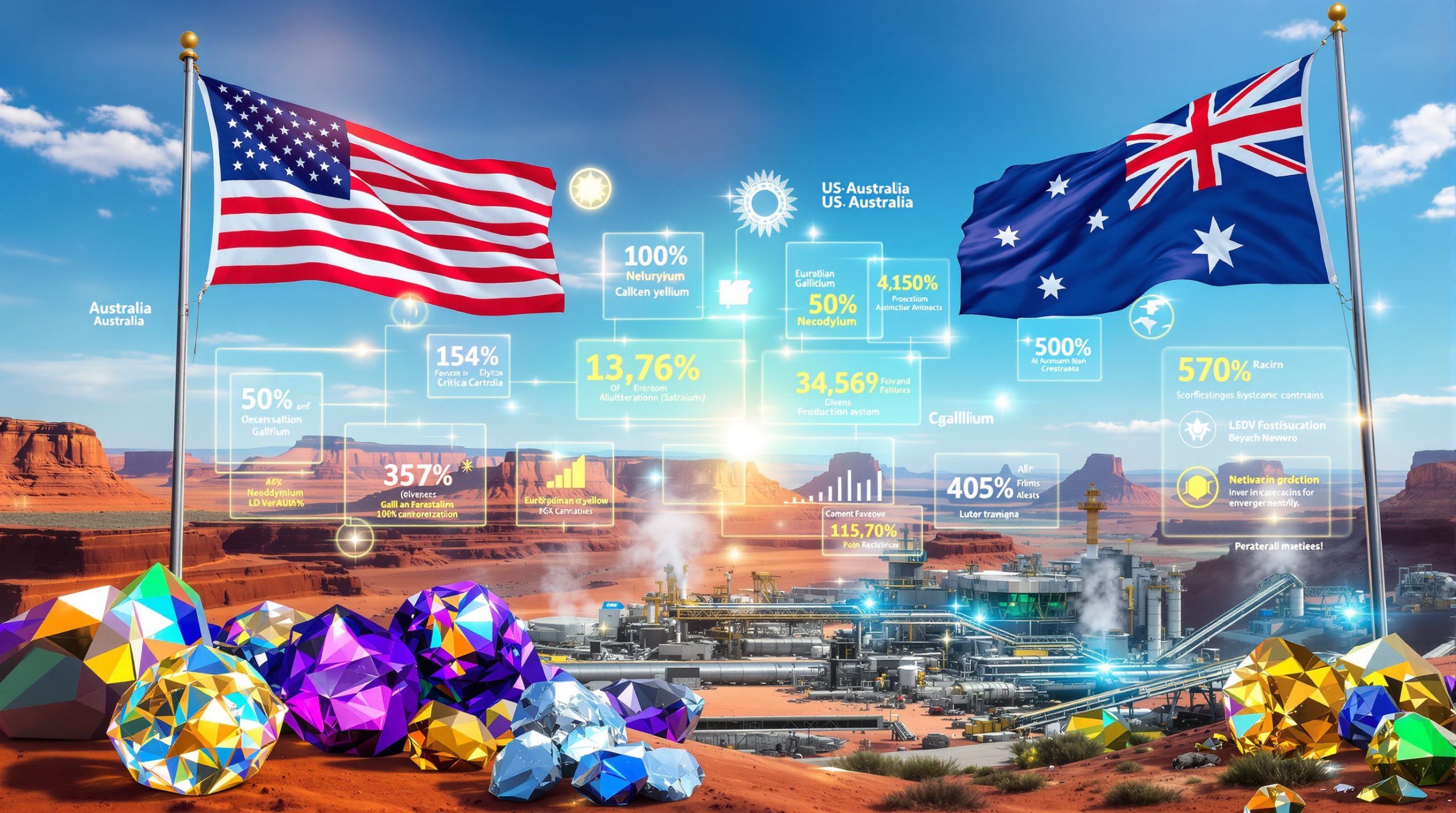What Are Rare Earth Elements and Why Are They Important?
Rare earth elements (REEs) comprise a group of 15 lanthanide elements, plus yttrium, that possess unique magnetic, optical, and electronic properties. Despite their name, these elements aren't particularly rare in Earth's crust, but economically viable concentrations are uncommon. With a global annual mining output of approximately 400,000 tonnes, these elements have become fundamental to modern technology and the clean energy transition.
The term "rare earths" is somewhat misleading – these elements are actually relatively abundant in Earth's crust, but rarely found in concentrated, economically viable deposits. What makes them truly valuable isn't their scarcity but their exceptional properties that enable technologies essential to our modern world.
Key Properties and Applications
REEs have become essential components in modern technology due to their special properties, typically divided into two categories:
- Light Rare Earths (LREEs): Lanthanum, cerium, praseodymium, and neodymium
- Heavy Rare Earths (HREEs): Elements from samarium to lutetium, plus yttrium
These elements serve as critical ingredients in numerous applications:
| Element(s) | Applications |
|---|---|
| Lanthanum & Cerium | Rechargeable batteries, smartphone screens, catalytic converters |
| Praseodymium & Neodymium | Permanent magnets for wind turbines, electric vehicles, MRI machines |
| Gadolinium & Lutetium | Medical imaging (PET scans) |
| Terbium & Yttrium | Fiber optics, fluorescent lighting |
| Dysprosium | High-temperature permanent magnets |
The four "magnet rare earths" (praseodymium, neodymium, terbium, and dysprosium) are particularly crucial for the critical minerals in energy transition, driving approximately 80% of demand for REEs in clean energy technologies. As Dr. Karen Soldenhof from ANSTO noted, "The magnet REEs are the salt and pepper of modern technology—tiny quantities enable transformative applications like wind turbines and EVs."
The Value-Mass Paradox
A fascinating aspect of rare earth elements is the dramatic disconnect between their mass composition and economic value:
- In monazite, lanthanum and cerium comprise 70% of the mass but only 1% of the total value
- In xenotime, yttrium makes up 61% of the mass but only 11% of the value
- The magnet rare earths (Nd, Pr, Tb, Dy) often represent a small percentage of mass but the majority of value
This "value-mass paradox" creates significant processing challenges, as producers must process large volumes of material to extract relatively small amounts of the most valuable elements. As Dr. Soldenhof explains, "Processing 1 tonne of monazite yields 0.5kg of high-value dysprosium but 700kg of low-value lanthanum."
Why Is Australia Focusing on Rare Earth Development?
Australia's strategic focus on rare earth elements stems from several factors that position the country to become a significant player in the global supply chain. With China controlling 90% of global REE processing and Myanmar supplying 40,000 tonnes per year of HREEs via informal mining, diversification of supply has become a national priority.
Australia's commitment is evidenced by significant investment, including the Critical Minerals R&D Hub which received $3.4 billion under the Resourcing Australia's Prosperity initiative. This investment recognizes both the economic opportunity and strategic importance of rare earth development.
Supply Chain Vulnerabilities
The current REE supply chain faces significant concentration risks:
- China dominates nearly every stage of the supply chain
- Processing and separation capabilities are particularly concentrated
- Heavy rare earths (HREEs) production is almost exclusively controlled by China
- Informal mining in Myanmar has become a major source of HREEs with significant environmental concerns
This concentration creates vulnerabilities for industries dependent on these materials, particularly those involved in clean energy technologies and defense critical materials strategy. China's 2023 export restrictions on gallium and germanium highlighted how quickly supply chains can be disrupted when dominated by a single country.
Australia's Geological Potential
Australia possesses diverse geological settings favorable for REE deposits:
- Multiple deposit types across different regions
- Potential for both light and heavy rare earth elements
- Established mining expertise and infrastructure
- Strong regulatory framework for responsible resource development
Dr. Jessica Walsh from Geoscience Australia emphasizes this potential: "Clay-hosted deposits could disrupt China's HREE monopoly if we unlock economically viable extraction methods." Western Australia's Madura Basin clays, for example, hold approximately 500ppm Total Rare Earth Oxides (TREO) with 30% HREE content, representing a significant opportunity.
Economic and Strategic Benefits
Developing Australia's rare earth resources offers multiple advantages:
- Diversification of global supply chains
- Value-added processing opportunities
- Support for domestic manufacturing
- Strategic positioning in critical mineral markets
- Contribution to sustainable technology development
Australia aims to capture 15% of global REE processing by 2035, up from 7% today. This ambitious goal would significantly reduce global supply chain vulnerabilities while creating substantial economic opportunities domestically.
How Are Rare Earth Elements Found and Processed?
Major Rare Earth Minerals
Despite occurring in over 150 mineral types, only four minerals (monazite, bastnäsite, xenotime, and ion-adsorption clays) account for 95% of economically exploited REEs:
Light Rare Earth Minerals
- Monazite: A phosphate mineral found in heavy mineral sands and hard rock deposits
- Bastnäsite: Found at Mountain Pass, California and Bayan Obo, China
Heavy Rare Earth Sources
- Xenotime: Less common, can occur with monazite
- Ion-adsorption clays: Historically mined in southern China, with rare earths loosely bound to clay minerals
Dr. Mark Pownceby from CSIRO highlights an important distinction: "Residual minerals in regolith require aggressive acids, unlike ion-adsorption clays which can be processed with milder reagents." This distinction has significant implications for processing costs and environmental impact.
The Complete Supply Chain
The rare earth supply chain involves multiple specialized stages:
- Mining and Beneficiation: Extracting ore and concentrating the REE-bearing minerals
- Extraction: Breaking down mineral structures using acids or alkalis
- Separation: Dividing the mixed rare earth concentrate into individual elements
- Metallization: Converting oxides to metals and alloys
- Manufacturing: Producing components and end products
Australia has established capabilities in mining and beneficiation but has historically been less active in the downstream processing stages. This is changing with projects like ASM's Dubbo project, which processes 20,000 tonnes per year of zirconium-REE ore, and ANSTO's Kalgoorlie facility which uses hydrochloric acid cracking to dissolve REE phosphates at 300°C.
Australian Projects in Development
Several significant projects are advancing Australia's capabilities:
- Lynas Rare Earths: Operating the Mt Weld mine in Western Australia, with processing in Malaysia and a new cracking facility in Kalgoorlie
- Iluka Resources: Constructing a rare earth refinery at Eneabba, Western Australia, backed by a $1.25 billion federal loan to process monazite stockpiles
- Arafura Resources: Developing the Nolans Project, which combines mining and solvent extraction for NdPr production
- Hastings Technology Metals: Advancing the Yangibana mine which targets a 15:1 LREE:HREE ratio
- Northern Minerals: Focusing on the Browns Range project which targets dysprosium-rich xenotime
What Are the Challenges in Rare Earth Processing?
Separation Complexities
The most technically challenging aspect of rare earth processing is separation:
- Rare earth elements have extremely similar chemical properties
- Separation factors between adjacent elements are very low (often below 2)
- Separating neodymium from praseodymium requires 1,000+ solvent extraction stages due to separation factors of just 1.5
- Conventional solvent extraction requires hundreds of stages
- High purity requirements (99.99% or "4N" purity) for many applications
- Each separation circuit must be precisely calibrated
As Dr. Soldenhof explains, "The chemistry of rare earths is so similar that separating them is like trying to separate identical twins with slightly different heights—you need extremely precise and repetitive processes."
Environmental Considerations
Processing rare earths presents environmental challenges:
- Chemical-intensive separation processes
- Management of radioactive elements (thorium, uranium) that often occur with rare earths
- Water usage and waste management
- Energy requirements for multiple processing stages
Lynas' Malaysian plant, for example, generates approximately 1.2 million cubic meters of low-level radioactive waste annually. This has led to increased focus on developing more environmentally sustainable processing routes, particularly for Australian deposits.
Economic Viability
The economics of rare earth processing are complex:
- Small global market (approximately 400,000 tonnes annually)
- High capital costs for separation facilities
- Technical expertise requirements
- Market volatility and price fluctuations
- Competition with established producers
These challenges have led Australian companies to focus on strategic partnerships and government support. The US Department of Defense, for instance, funded Lynas' Texas separation plant with $120 million, recognizing the strategic importance of diversified supply chains.
How Is Australia Advancing Clay-Hosted Rare Earth Development?
The Critical Minerals R&D Hub
Australia has established a collaborative research initiative focused on rare earth development:
- Partnership between ANSTO, CSIRO, and Geoscience Australia
- Focus on lower-grade, clay-hosted rare earth deposits
- Emphasis on deposits with higher proportions of heavy rare earths
- Development of environmentally responsible processing methods
This collaborative approach brings together three distinct areas of expertise: ANSTO's 30+ years of experience in rare earth processing, CSIRO's materials characterization capabilities, and Geoscience Australia's mineral systems approach to exploration.
Understanding Clay-Hosted Deposits
Clay-hosted rare earth deposits present both opportunities and challenges:
- Ion-adsorption deposits: Rare earths loosely bound to clay minerals, potentially extractable with mild reagents like ammonium sulfate
- Residual mineral deposits: Rare earths in weathered mineral phases requiring more aggressive processing
- Understanding the distinction is crucial for processing design
CSIRO's XRD analysis identifies clay fractions smaller than 2 micrometers for selective leaching, while electromagnetic surveys correlate 10–20 Siemens conductivity with REE-rich zones. These technical approaches help identify the most promising deposits for development.
The Mineral Systems Approach
Geoscience Australia is applying a mineral systems framework to understand clay-hosted deposits:
- Source: Identifying the original source of rare earth elements
- Energy and fluid flow: Understanding weathering processes
- Architecture and pathways: Mapping regolith profiles and fluid movement
- Deposition: Determining where and how rare earths concentrate
- Preservation: Assessing long-term stability of deposits
Dr. Walsh highlights the practical application of this approach: "Our mineral systems approach identifies paleochannels as HREE traps in transported regolith." This methodology has reduced exploration costs by approximately 40% in underexplored regions through the development of mineral potential models.
Deposit-Scale Investigations
CSIRO is conducting detailed studies at specific deposits to understand:
- Distribution of rare earths within regolith profiles
- Distinction between in-situ and transported material
- Mineralogical characterization of rare earth hosts
- Correlation with geophysical signatures
- Processing implications of different mineralization styles
CSIRO's Mt. Weld study linked saprolite weathering to REE enrichment, while King Island Scheelite's Dolphin Project combines geophysics and XRD to map ionic clays. These investigations provide critical insights for both exploration and processing design.
What Are the Future Prospects for Australia's Rare Earth Industry?
Expanding Processing Capabilities
Australia is working to establish more comprehensive processing capabilities:
- Development of separation expertise
- Construction of commercial-scale facilities
- Integration of upstream and downstream operations
- Research into more efficient processing technologies
ANSTO's patented ion-exchange resins for HREE recovery and ASM's hydrogen reduction methods at their Korean plant, which yield 99.9% NdFeB alloys, represent significant advances in Australian processing technology.
Targeting Heavy Rare Earths
A strategic focus on heavy rare earth resources could address a critical supply gap:
- Exploration for clay-hosted deposits with favorable HREE profiles
- Development of processing routes specific to Australian mineralogy
- Potential to provide alternatives to current supply sources
As Dr. Pownceby notes, "Recycling EV magnets could supply 20% of REE demand by 2040," presenting another avenue for Australia to develop sustainable REE supply chains alongside primary production.
Supply Chain Integration
Australia has opportunities to participate in more complete supply chains:
- Partnerships with manufacturing hubs in allied nations
- Development of metallization capabilities
- Support for domestic manufacturing utilizing rare earth products
- Participation in recycling and circular economy initiatives
The European Raw Materials Alliance is forming partnerships with Australian miners to bypass Chinese supply, while Pilbara Minerals' blockchain pilot tracks REE provenance for ESG compliance. These initiatives demonstrate growing international interest in Australia's rare earth potential.
Research and Innovation
Ongoing research initiatives aim to overcome key challenges:
- More efficient separation technologies
- Environmentally optimized processing methods
- Better characterization of deposit types
- Integration of exploration and processing considerations
Geoscience Australia's national-scale mineral potential maps under the R&D Hub provide a foundation for strategic exploration, while CSIRO's regolith mapping using hyperspectral data enhances target identification. However, addressing workforce shortages in hydrometallurgy through STEM initiatives remains a challenge for the industry's growth.
Conclusion: Australia's Rare Earth Opportunity
Australia stands at a pivotal moment in rare earth element development. With significant geological potential, growing technical expertise, and strategic importance, the country has the opportunity to become a major player in global rare earth supply chains.
The collaborative approach between government research agencies and industry partners demonstrates a commitment to addressing the technical, economic, and environmental challenges associated with rare earth development. By focusing on clay-hosted deposits with potential for heavy rare earths, Australia is targeting a critical supply gap in the global market.
Success will require continued investment in research, processing infrastructure, and market development. However, the potential benefits extend beyond economic returns to include supply chain security, environmental improvements, and support for the raw materials for green transition. Furthermore, the development of Australia's critical minerals reserve could help mitigate risks associated with surging critical minerals demand.
The development and processing of rare earth elements in Australia represents not just an economic opportunity but a strategic imperative in an increasingly resource-competitive world. With continued innovation and investment, Australia is positioned to play a crucial role in securing the materials needed for the technologies of tomorrow.
Want to Stay Ahead of the Next Major Mineral Discovery?
Discovery Alert's proprietary Discovery IQ model instantly notifies investors about significant ASX mineral discoveries, turning complex data into actionable investment insights. Understand why major discoveries like rare earth elements can lead to exceptional returns by exploring the dedicated discoveries page.




